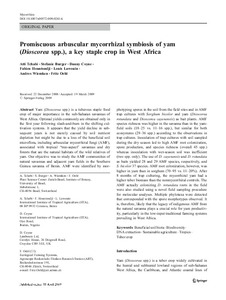| dc.contributor.author | Tchabi, A. |
| dc.contributor.author | Burger, S. |
| dc.contributor.author | Coyne, D.L. |
| dc.contributor.author | Hountondji, F.C.C. |
| dc.contributor.author | Lawouin, L. |
| dc.contributor.author | Wiemken, A. |
| dc.contributor.author | Oehl, F. |
| dc.date.accessioned | 2019-12-04T11:11:54Z |
| dc.date.available | 2019-12-04T11:11:54Z |
| dc.date.issued | 2009-04 |
| dc.identifier.citation | Tchabi, A., Burger, S., Coyne, D., Hountondji, F., Lawouin, L., Wiemken, A. & Oehl, F. (2009). Promiscuous arbuscular mycorrhizal symbiosis of yam (Dioscorea spp.), a key staple crop in West Africa. Mycorrhiza, 19(6), 375-392. |
| dc.identifier.issn | 1432-1890 |
| dc.identifier.uri | https://hdl.handle.net/20.500.12478/2520 |
| dc.description.abstract | Yam (Dioscoreaspp.) is a tuberous staple foodcrop of major importance in the sub-Saharan savannas ofWest Africa. Optimal yields commonly are obtained only inthe first year following slash-and-burn in the shifting cul-tivation systems. It appears that the yield decline in sub-sequent years is not merely caused by soil nutrientdepletion but might be due to a loss of the beneficial soilmicroflora, including arbuscular mycorrhizal fungi (AMF),associated with tropical“tree-aspect”savannas and dryforests that are the natural habitats of the wild relatives ofyam. Our objective was to study the AMF communities ofnatural savannas and adjacent yam fields in the SouthernGuinea savanna of Benin. AMF were identified by mor-photyping spores in the soil from the field sites and in AMFtrap cultures withSorghum bicolorand yam (DioscorearotundataandDioscorea cayenensis) as bait plants. AMFspecies richness was higher in the savanna than in the yam-field soils (18–25 vs. 11–16 spp.), but similar for bothecosystems (29–36 spp.) according to the observations intrap cultures. Inoculation of trap cultures with soil sampledduring the dry season led to high AMF root colonization,spore production, and species richness (overall 45 spp.)whereas inoculation with wet-season soil was inefficient(two spp. only). The use ofD. cayenensisandD. rotundataas baits yielded 28 and 29 AMF species, respectively, andS. bicolor37 species. AMF root colonization, however, washigher in yam than in sorghum (70–95 vs. 11–20%). After8 months of trap culturing, the mycorrhizal yam had ahigher tuber biomass than the nonmycorrhizal controls. TheAMF actually colonizingD. rotundataroots in the fieldwere also studied using a novel field sampling procedurefor molecular analyses. Multiple phylotaxa were detectedthat corresponded with the spore morphotypes observed. Itis, therefore, likely that the legacy of indigenous AMF fromthe natural savanna plays a crucial role for yam productiv-ity, particularly in the low-input traditional farming systemsprevailing in West Africa. |
| dc.description.sponsorship | Swiss Center for International Agriculture |
| dc.format.extent | 375-392 |
| dc.language.iso | en |
| dc.publisher | Mycorrhiza |
| dc.subject | Beneficial Soil Biota |
| dc.subject | Biodiversity |
| dc.subject | Dna Extraction |
| dc.subject | Sustainable Agriculture |
| dc.subject | Tropics |
| dc.subject | Yams |
| dc.subject | Dioscorea Rotundata And Dioscorea Cayenensis |
| dc.subject | Mycorrhiza |
| dc.title | Promiscuous arbuscular mycorrhizal symbiosis of yam (Dioscorea spp.), a key staple crop in West Africa |
| dc.type | Journal Article |
| dc.description.version | Peer Review |
| cg.contributor.affiliation | University of Basel |
| cg.contributor.affiliation | International Institute of Tropical Agriculture |
| cg.contributor.affiliation | Agroscope Research Station, Switzerland |
| cg.coverage.region | Acp |
| cg.coverage.region | Africa |
| cg.coverage.region | Europe |
| cg.coverage.region | West Africa |
| cg.coverage.country | Switzerland |
| cg.coverage.country | Benin |
| cg.coverage.country | Nigeria |
| cg.authorship.types | CGIAR and developing country institute |
| cg.iitasubject | Yam |
| cg.iitasubject | Plant Production |
| cg.iitasubject | Plant Breeding |
| cg.iitasubject | Plant Diseases |
| cg.iitasubject | Research Method |
| cg.iitasubject | Food Security |
| cg.iitasubject | Disease Control |
| cg.journal | Mycorrhiza |
| cg.howpublished | Formally Published |
| cg.accessibilitystatus | Limited Access |
| local.dspaceid | 93271 |
| cg.identifier.doi | https://dx.doi.org/10.1007/s00572-009-0241-6 |

